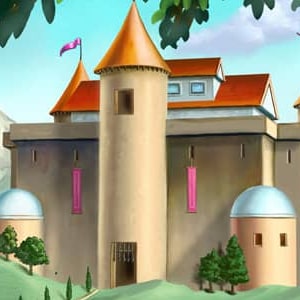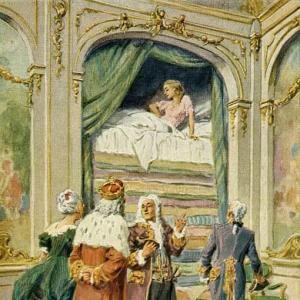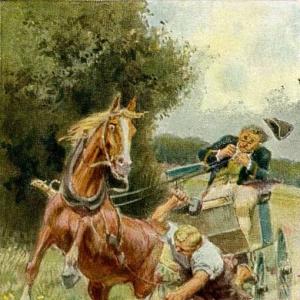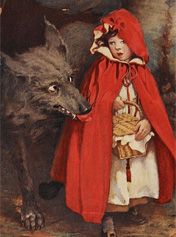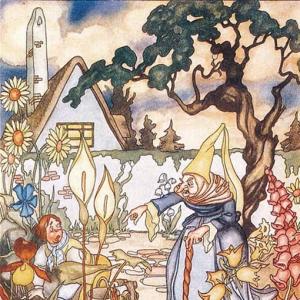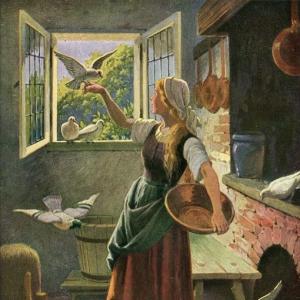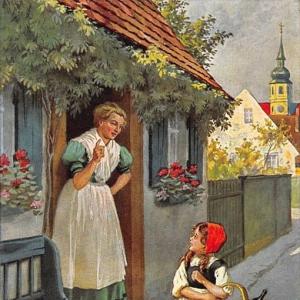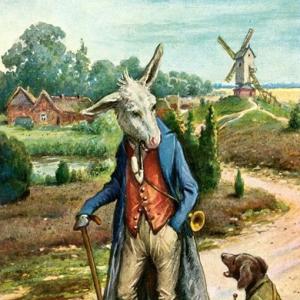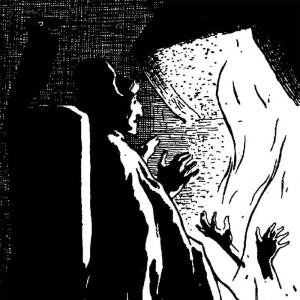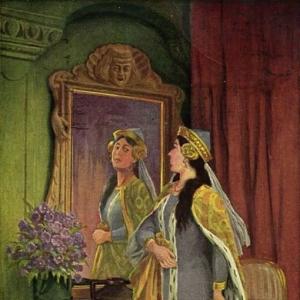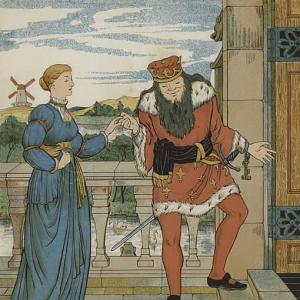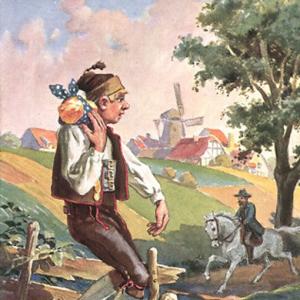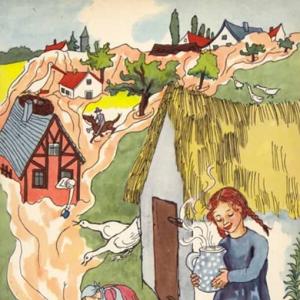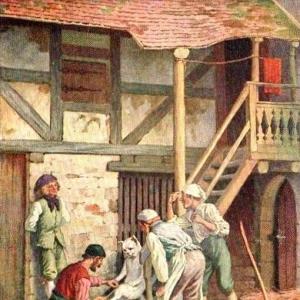Reading time: 6 min
A certain tailor who was great at boasting but ill at doing, took it into his head to go abroad for a while, and look about the world. As soon as he could manage it, he left his workshop, and wandered on his way, over hill and dale, sometimes hither, sometimes thither, but ever on and on. Once when he was out he perceived in the blue distance a steep hill, and behind it a tower reaching to the clouds, which rose up out of a wild dark forest. „Thunder and lightning,“ cried the tailor, „what is that?“ and as he was strongly goaded by curiosity, he went boldly towards it. But what made the tailor open his eyes and mouth when he came near it, was to see that the tower had legs, and leapt in one bound over the steep hill, and was now standing as an all powerful giant before him. „What dost thou want here, thou tiny fly’s leg?“ cried the giant, with a voice as if it were thundering on every side. The tailor whimpered, „I want just to look about and see if I can earn a bit of bread for myself, in this forest.“ If that is what thou art after,“ said the giant, „thou mayst have a place with me.“ – „If it must be, why not? What wages shall I receive?“ – „Thou shalt hear what wages thou shalt have. Every year three hundred and sixty-five days, and when it is leap-year, one more into the bargain. Does that suit thee?“ – „All right,“ replied the tailor, and thought, in his own mind, „a man must cut his coat according to his cloth. I will try to get away as fast as I can.“ On this the giant said to him, „Go, little ragamuffin, and fetch me a jug of water.“ – „Had I not better bring the well itself at once, and the spring too?“ asked the boaster, and went with the pitcher to the water. „What! the well and the spring too,“ growled the giant in his beard, for he was rather clownish and stupid, and began to be afraid. „That knave is not a fool, he has a wizard in his body. Be on thy guard, old Hans, this is no serving-man for thee.“ When the tailor had brought the water, the giant bade him go into the forest, and cut a couple of blocks of wood and bring them back. „Why not the whole forest, at once, with one stroke. The whole forest, young and old, with all that is there, both rough and smooth?“ asked the little tailor, and went to cut the wood. „What! the whole forest, young and old, with all that is there, both rough and smooth, and the well and its spring too,“ growled the credulous giant in his beard, and was still more terrified. „The knave can do much more than bake apples, and has a wizard in his body. Be on thy guard, old Hans, this is no serving-man for thee!“ When the tailor had brought the wood, the giant commanded him to shoot two or three wild boars for supper. „Why not rather a thousand at one shot, and bring them all here?“ inquired the ostentatious tailor. „What!“ cried the timid giant in great terror; „Let well alone to-night, and lie down to rest.“
The giant was so terribly alarmed that he could not close an eye all night long for thinking what would be the best way to get rid of this accursed sorcerer of a servant. Time brings counsel. Next morning the giant and the tailor went to a marsh, round which stood a number of willow-trees. Then said the giant, „Hark thee, tailor, seat thyself on one of the willow-branches, I long of all things to see if thou art big enough to bend it down.“ All at once the tailor was sitting on it, holding his breath, and making himself so heavy that the bough bent down. When, however, he was compelled to draw breath, it hurried him (for unfortunately he had not put his vgoose in his pocket) so high into the air that he never was seen again, and this to the great delight of the giant. If the tailor has not fallen down again, he must be hovering about in the air.
 Learn languages. Double-tap on a word.Learn languages in context with Childstories.org and Deepl.com.
Learn languages. Double-tap on a word.Learn languages in context with Childstories.org and Deepl.com.Backgrounds
Interpretations
Adaptions
Summary
Linguistics
„The Giant and the Tailor“ is a lesser-known German fairy tale collected by the Brothers Grimm, Jacob (1785-1863) and Wilhelm (1786-1859) Grimm. The brothers were German academics, philologists, cultural researchers, and authors who are best known for their collection of folktales, which aimed to preserve the rich oral storytelling tradition of Germany and other European countries. Their work, known as „Grimms‘ Fairy Tales“ or „Children’s and Household Tales“ (Kinder- und Hausmärchen), was first published in 1812 and has since become a classic in Western literature.
The Brothers Grimm collected these tales from various sources, such as friends, acquaintances, and printed collections of folktales. Many of their stories, including „The Giant and the Tailor,“ have been passed down through generations and were influenced by the socio-cultural context of the time, reflecting the values and norms of the society in which they were created. Fairy tales like these were often shared orally and evolved over time, allowing for variations in different retellings.
„The Giant and the Tailor“ is a story about a boastful tailor who, through his cunning and wit, manages to outsmart a giant. The story showcases themes such as boasting, deception, intelligence, gullibility, and fear. Like many other fairy tales, it conveys moral lessons and highlights the importance of honesty, critical thinking, and the power of wit and resourcefulness in overcoming obstacles.
„The Giant and the Tailor“ can be interpreted in several ways, focusing on different aspects such as the themes of boasting, trickery, and fear.
Boasting and deception: The tailor’s consistent exaggerations of his abilities highlight the perils of boasting and dishonesty. Though his false claims initially help him gain an advantage, they eventually lead to his precarious situation when he is launched into the sky. This serves as a cautionary tale, suggesting that dishonesty and overconfidence may lead to one’s own downfall.
Overcoming fear through wit: Despite being significantly smaller and weaker than the giant, the tailor uses his cleverness to manipulate the situation to his advantage. By playing on the giant’s gullibility and fears, the tailor is able to avoid doing difficult tasks and maintain a sense of control. This interpretation emphasizes the power of wit and intelligence to overcome seemingly insurmountable challenges.
The danger of gullibility: The giant is easily swayed by the tailor’s claims, becoming increasingly frightened of the supposed sorcerer. The giant’s gullibility highlights the importance of critical thinking and skepticism when dealing with others, particularly those who make outlandish claims. In this sense, the story can be viewed as a warning to not blindly believe everything one hears.
Fear and misunderstanding: The giant’s growing fear of the tailor demonstrates how a lack of understanding or knowledge about someone can lead to misplaced anxiety and paranoia. The giant never truly attempts to understand or communicate with the tailor, which exacerbates the situation. This aspect of the story serves as a reminder to seek understanding and engage in open communication to avoid unnecessary fear and conflict.
„The Giant and the Tailor“ is a classic fairy tale that has inspired numerous adaptations in various forms of media. Some of the most notable adaptations of the tale include.
„The Valiant Little Tailor“ (1938) – This animated short film by Walt Disney Productions follows the story of the tailor who outwits seven flies and gains the reputation of a giant killer.
„The Adventures of Pinocchio“ (1883) – This novel by Carlo Collodi features a chapter in which Pinocchio meets a giant who has been tricked by a small tailor.
„The BFG“ (1982) – This novel by Roald Dahl features a friendly giant who befriends a young girl and helps her fight against evil giants.
„Gulliver’s Travels“ (1726) – This novel by Jonathan Swift features a scene in which Gulliver is captured by a giant and uses his intelligence to escape.
„The Giant Killer“ (1818) – This play by George Peele is a reworking of the story, featuring a hero who slays a giant and wins the heart of a princess.
„The Brave Little Tailor“ (1938) – This animated short film by Disney features a similar story to „The Giant and the Tailor,“ with the tailor tricking two giants and becoming a hero.
„The Giant of Marathon“ (1959) – This film is a loose adaptation of the tale, featuring a Greek soldier who must defeat a Persian giant to save his people.
Overall, „The Giant and the Tailor“ has been adapted into various forms of media, each offering their own interpretation of the classic tale.
„The Giant and the Tailor“ is a fairy tale by the Brothers Grimm about a boastful tailor who sets off on a journey to explore the world. One day, he discovers a tower with legs that jumps over a hill and transforms into a giant. The giant questions the tailor’s presence and, upon learning that the tailor seeks work, offers him a job with 365 days of wages per year.
Although intimidated, the tailor accepts the job and is given various tasks by the giant, including fetching water, cutting wood, and hunting wild boars. The tailor exaggerates his abilities to complete these tasks, leading the gullible giant to believe that he has a wizard inside him. This causes the giant to grow increasingly terrified of the tailor, whom he perceives as a dangerous sorcerer.
Unable to sleep due to fear, the giant devises a plan to get rid of the tailor. He takes him to a marsh surrounded by willow trees and asks the tailor to sit on a branch to see if he can bend it. The tailor holds his breath and manages to bend the branch, but when he has to breathe again, he is catapulted into the sky, disappearing from the giant’s sight. The giant is relieved to be rid of the supposed sorcerer, while the tailor’s fate remains unknown, as he is said to be hovering in the air if he has not yet fallen back to the ground.
The fairy tale „The Giant and the Tailor“ by Brothers Grimm provides a fascinating opportunity for linguistic analysis. Let us explore various linguistic features present in this narrative:
Narrative Structure
Exposition: The story begins with an introduction to the tailor—a boastful, itinerant character with a talent for exaggeration rather than action.
Rising Action: The tailor encounters a giant and negotiates employment, revealing his tendency for hyperbolic statements.
Climax: The giant becomes increasingly fearful of the tailor’s boasts, assuming him to possess magical powers.
Falling Action and Resolution: The tailor is tricked by the giant into sitting on a willow branch and is flung into the air, disappearing from sight.
Language Features
Dialogue: The use of direct speech serves to reveal character traits. The tailor’s words are marked by bravado and rhetorical questions, while the giant’s dialogue reflects gullibility and growing fear.
Hyperbole: The tailor’s exaggerated statements („Why not the whole forest, at once, with one stroke“) exemplify hyperbole, a device that adds both humor and tension to the narrative.
Imagery: Vivid descriptions, such as the „tower reaching to the clouds“ and „wild dark forest,“ create an engaging setting and emphasize the fantastical elements of the tale.
Metaphor and Simile: The tailor is metaphorically referred to as a „tiny fly’s leg“ in comparison to the powerful giant, highlighting his smallness and apparent insignificance.
Repetition: Phrases like „Thunder and lightning“ and „What!“ create rhythm and emphasize the giant’s disbelief and fear in response to the tailor’s claims.
Irony: There is situational irony in the tailor’s success through deception and the giant’s failure despite his physical power.
Themes
Deception and Wit: The tale explores themes of cunning over brawn, where wit and verbal dexterity allow the tailor to manipulate situations to his advantage.
The Power of Fear and Imagination: The giant’s fear is amplified by his imagination, driven by the tailor’s exaggerated claims.
Social Commentary: The tailor’s journey from boasting to survival by trickery can be seen as a satire on social hierarchies, where those in power are not always the most intelligent.
Syntax and Diction
Sentence Length and Structure: Varying sentence lengths, from short and abrupt to long and complex, effectively build tension and convey character emotions.
Archaic Language: Words like „thou“ and „thee“ lend the story a timeless, fairy-tale quality consistent with the oral storytelling tradition.
Overall, „The Giant and the Tailor“ showcases the Brothers Grimm’s masterful use of linguistic devices to create an entertaining and thought-provoking fairy tale. The interplay between character, language, and theme offers readers enduring insights into human nature.
Information for scientific analysis
Fairy tale statistics | Value |
|---|---|
| Number | KHM 183 |
| Aarne-Thompson-Uther-Index | ATU Typ 1049 |
| Translations | DE, EN, DA, ES, PT, IT, JA, NL, PL, RU, TR, VI, ZH |
| Readability Index by Björnsson | 24.8 |
| Flesch-Reading-Ease Index | 85.9 |
| Flesch–Kincaid Grade-Level | 5.4 |
| Gunning Fog Index | 7.6 |
| Coleman–Liau Index | 7.1 |
| SMOG Index | 6.9 |
| Automated Readability Index | 5.3 |
| Character Count | 3.766 |
| Letter Count | 2.856 |
| Sentence Count | 44 |
| Word Count | 733 |
| Average Words per Sentence | 16,66 |
| Words with more than 6 letters | 60 |
| Percentage of long words | 8.2% |
| Number of Syllables | 901 |
| Average Syllables per Word | 1,23 |
| Words with three Syllables | 18 |
| Percentage Words with three Syllables | 2.5% |

 Facebook
Facebook  Whatsapp
Whatsapp  Messenger
Messenger  Telegram
Telegram Reddit
Reddit